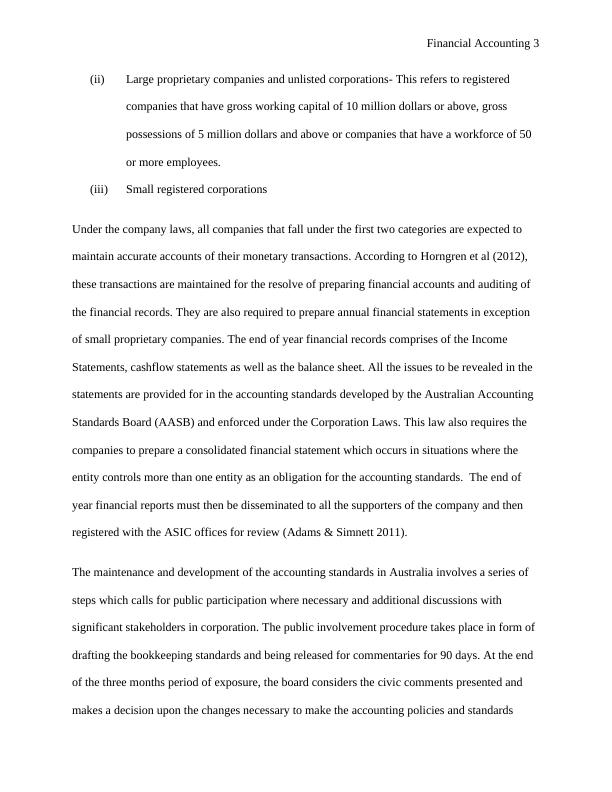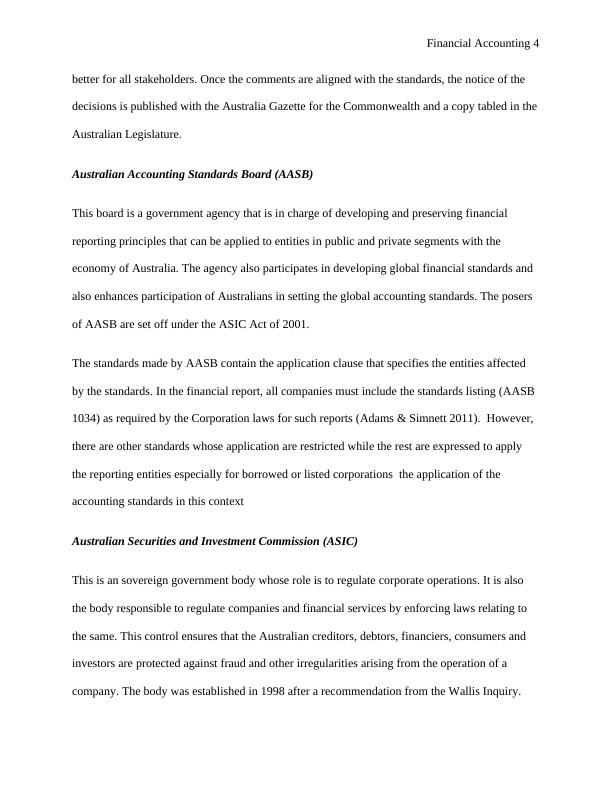Financial Accounting Practices in Australia
Added on 2023-06-11
18 Pages5088 Words280 Views
Financial Accounting 1
FINANCIAL ACCOUNTING
Author
Course Title
Professor
City
Date
FINANCIAL ACCOUNTING
Author
Course Title
Professor
City
Date

Financial Accounting 2
Introduction
The report presents analysis of some of the accounting practices carried out in Australia. It starts
with identification and discussion of some of the main source of the regulation to financial
reporting in Australia. This is followed by discussion of some of the procedures followed while
preparing accounting standards in the country. It also highlights how the accounting standards
are being enforced within Australia. This is not all; the report discusses critically how users of
the financial information presented in the general purpose financial report have identical needs
which are all met through the GPFR. It also highlights some of the limitations associated with
Present Value as the key measurement base in producing decision-useful information for the
users of financial statements. It is then concluded with a discussion of some of the limitations of
the AASB 138 in providing useful information for decision making by different users of the
financial information.
Identification and discussion of the main sources of regulation of the financial reporting in
Australia
According to Henderson et al (2015), Australia has a different accounting and financial
disclosure system than UK or US. The financial reporting needs are fixed in accordance with the
types of entities involved based on the level of interest the community have on an institution.
The types of entity can primarily be classified into one of the following;
(i) Disclosing entities- this classification is mainly for listed companies or listed
managed venture organizations which have known interest undertaking. These
companies have registered securities or issue shares to the public in addition to other
securities based on the circulation of a prospectus.
Introduction
The report presents analysis of some of the accounting practices carried out in Australia. It starts
with identification and discussion of some of the main source of the regulation to financial
reporting in Australia. This is followed by discussion of some of the procedures followed while
preparing accounting standards in the country. It also highlights how the accounting standards
are being enforced within Australia. This is not all; the report discusses critically how users of
the financial information presented in the general purpose financial report have identical needs
which are all met through the GPFR. It also highlights some of the limitations associated with
Present Value as the key measurement base in producing decision-useful information for the
users of financial statements. It is then concluded with a discussion of some of the limitations of
the AASB 138 in providing useful information for decision making by different users of the
financial information.
Identification and discussion of the main sources of regulation of the financial reporting in
Australia
According to Henderson et al (2015), Australia has a different accounting and financial
disclosure system than UK or US. The financial reporting needs are fixed in accordance with the
types of entities involved based on the level of interest the community have on an institution.
The types of entity can primarily be classified into one of the following;
(i) Disclosing entities- this classification is mainly for listed companies or listed
managed venture organizations which have known interest undertaking. These
companies have registered securities or issue shares to the public in addition to other
securities based on the circulation of a prospectus.

Financial Accounting 3
(ii) Large proprietary companies and unlisted corporations- This refers to registered
companies that have gross working capital of 10 million dollars or above, gross
possessions of 5 million dollars and above or companies that have a workforce of 50
or more employees.
(iii) Small registered corporations
Under the company laws, all companies that fall under the first two categories are expected to
maintain accurate accounts of their monetary transactions. According to Horngren et al (2012),
these transactions are maintained for the resolve of preparing financial accounts and auditing of
the financial records. They are also required to prepare annual financial statements in exception
of small proprietary companies. The end of year financial records comprises of the Income
Statements, cashflow statements as well as the balance sheet. All the issues to be revealed in the
statements are provided for in the accounting standards developed by the Australian Accounting
Standards Board (AASB) and enforced under the Corporation Laws. This law also requires the
companies to prepare a consolidated financial statement which occurs in situations where the
entity controls more than one entity as an obligation for the accounting standards. The end of
year financial reports must then be disseminated to all the supporters of the company and then
registered with the ASIC offices for review (Adams & Simnett 2011).
The maintenance and development of the accounting standards in Australia involves a series of
steps which calls for public participation where necessary and additional discussions with
significant stakeholders in corporation. The public involvement procedure takes place in form of
drafting the bookkeeping standards and being released for commentaries for 90 days. At the end
of the three months period of exposure, the board considers the civic comments presented and
makes a decision upon the changes necessary to make the accounting policies and standards
(ii) Large proprietary companies and unlisted corporations- This refers to registered
companies that have gross working capital of 10 million dollars or above, gross
possessions of 5 million dollars and above or companies that have a workforce of 50
or more employees.
(iii) Small registered corporations
Under the company laws, all companies that fall under the first two categories are expected to
maintain accurate accounts of their monetary transactions. According to Horngren et al (2012),
these transactions are maintained for the resolve of preparing financial accounts and auditing of
the financial records. They are also required to prepare annual financial statements in exception
of small proprietary companies. The end of year financial records comprises of the Income
Statements, cashflow statements as well as the balance sheet. All the issues to be revealed in the
statements are provided for in the accounting standards developed by the Australian Accounting
Standards Board (AASB) and enforced under the Corporation Laws. This law also requires the
companies to prepare a consolidated financial statement which occurs in situations where the
entity controls more than one entity as an obligation for the accounting standards. The end of
year financial reports must then be disseminated to all the supporters of the company and then
registered with the ASIC offices for review (Adams & Simnett 2011).
The maintenance and development of the accounting standards in Australia involves a series of
steps which calls for public participation where necessary and additional discussions with
significant stakeholders in corporation. The public involvement procedure takes place in form of
drafting the bookkeeping standards and being released for commentaries for 90 days. At the end
of the three months period of exposure, the board considers the civic comments presented and
makes a decision upon the changes necessary to make the accounting policies and standards

Financial Accounting 4
better for all stakeholders. Once the comments are aligned with the standards, the notice of the
decisions is published with the Australia Gazette for the Commonwealth and a copy tabled in the
Australian Legislature.
Australian Accounting Standards Board (AASB)
This board is a government agency that is in charge of developing and preserving financial
reporting principles that can be applied to entities in public and private segments with the
economy of Australia. The agency also participates in developing global financial standards and
also enhances participation of Australians in setting the global accounting standards. The posers
of AASB are set off under the ASIC Act of 2001.
The standards made by AASB contain the application clause that specifies the entities affected
by the standards. In the financial report, all companies must include the standards listing (AASB
1034) as required by the Corporation laws for such reports (Adams & Simnett 2011). However,
there are other standards whose application are restricted while the rest are expressed to apply
the reporting entities especially for borrowed or listed corporations the application of the
accounting standards in this context
Australian Securities and Investment Commission (ASIC)
This is an sovereign government body whose role is to regulate corporate operations. It is also
the body responsible to regulate companies and financial services by enforcing laws relating to
the same. This control ensures that the Australian creditors, debtors, financiers, consumers and
investors are protected against fraud and other irregularities arising from the operation of a
company. The body was established in 1998 after a recommendation from the Wallis Inquiry.
better for all stakeholders. Once the comments are aligned with the standards, the notice of the
decisions is published with the Australia Gazette for the Commonwealth and a copy tabled in the
Australian Legislature.
Australian Accounting Standards Board (AASB)
This board is a government agency that is in charge of developing and preserving financial
reporting principles that can be applied to entities in public and private segments with the
economy of Australia. The agency also participates in developing global financial standards and
also enhances participation of Australians in setting the global accounting standards. The posers
of AASB are set off under the ASIC Act of 2001.
The standards made by AASB contain the application clause that specifies the entities affected
by the standards. In the financial report, all companies must include the standards listing (AASB
1034) as required by the Corporation laws for such reports (Adams & Simnett 2011). However,
there are other standards whose application are restricted while the rest are expressed to apply
the reporting entities especially for borrowed or listed corporations the application of the
accounting standards in this context
Australian Securities and Investment Commission (ASIC)
This is an sovereign government body whose role is to regulate corporate operations. It is also
the body responsible to regulate companies and financial services by enforcing laws relating to
the same. This control ensures that the Australian creditors, debtors, financiers, consumers and
investors are protected against fraud and other irregularities arising from the operation of a
company. The body was established in 1998 after a recommendation from the Wallis Inquiry.

End of preview
Want to access all the pages? Upload your documents or become a member.
Related Documents
Accounting Theory and Current Issueslg...
|13
|4036
|72
Key Sources of Financial Reporting in Australialg...
|8
|1656
|73
Identification of Practices And Evaluation of Practiceslg...
|12
|2111
|16
Accounting Theory and Current Issueslg...
|14
|3970
|80
Essay on Corporations Actlg...
|11
|3251
|324
MPA 701 - Financial Reporting System in Australialg...
|10
|1802
|45
